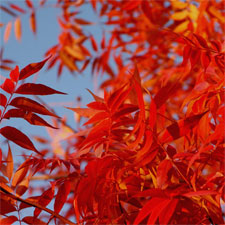Chinese Pistachio in Texas

Even those of us who feel that having a plant that is adapted to our locale is a lot more important than having one that is native, have to admit that most of our good landscaping trees are, indeed, natives. Chinese pistachio is the exception.
Texans first sampled this tree many, many decades ago. My first experience with it was in a home garden in North Dallas in the early 1970s. I’d been asked to write a story on a particular tree in a lady’s front yard. When I arrived, I realized that the mature plant was a Chinese pistachio, obviously 30 or 40 years old even then. It was the same size and shape as a mature Shumard red oak, and its fall color was beautiful. (As I left the neighborhood, I noticed a dozen or more seedling trees that had come up in others’ yards and hedgerows.)
The big push toward Chinese pistachios started in the 1980s. It has hit full stride in the past 20 years. Now, they’re common in new landscaping in almost every city in the state.
Here are one guy’s observations on this fine tree:
• Growth rate is moderate to moderately fast – comparable to most high quality oaks, for example.
• Mature size: 40 to 50 ft. tall and wide.
• Fall color: scarlet red. Better some years than others.
• Female plants produce large numbers of colorful, red fruit. Male plants do not bear fruit.
• Container-grown trees establish more quickly and easily than balled-and-burlapped ones.
• New Chinese pistachios tend to grow rather leggy initially. You may occasionally need to tip-prune their growing tips one time to force them to produce side branches.
• As with Shumard red oaks, trunks of new Chinese pistachios MUST be protected with paper tree wrap from the nursery or hardware store to guard against sunscald and subsequent borer invasion. Leave the wrap in place a year or two.
Neil Sperry

